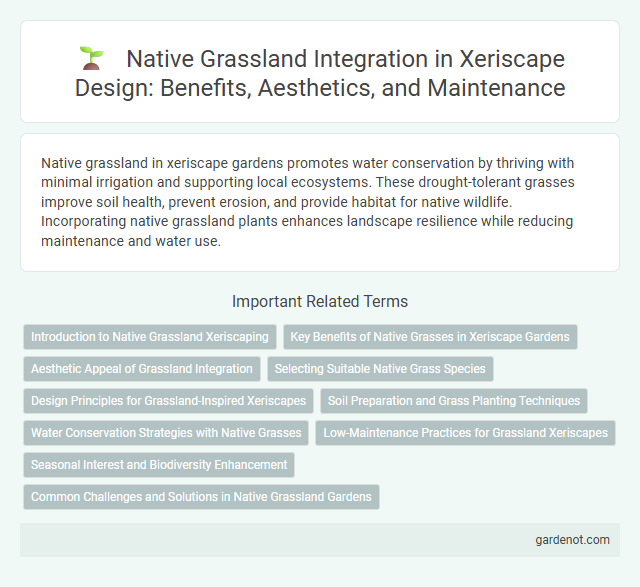Native grassland in xeriscape gardens promotes water conservation by thriving with minimal irrigation and supporting local ecosystems. These drought-tolerant grasses improve soil health, prevent erosion, and provide habitat for native wildlife. Incorporating native grassland plants enhances landscape resilience while reducing maintenance and water use.
Introduction to Native Grassland Xeriscaping
Native grassland xeriscaping utilizes drought-tolerant grasses like little bluestem and switchgrass to create sustainable landscapes that conserve water and support local ecosystems. This landscaping technique reduces irrigation needs by mimicking natural grassland conditions, promoting soil health and biodiversity. Xeriscaped native grasslands also enhance resilience to climate variability while providing habitat for pollinators and wildlife.
Key Benefits of Native Grasses in Xeriscape Gardens
Native grasses in xeriscape gardens significantly reduce water consumption due to their deep root systems adapted to local climates, enhancing drought resistance. These grasses improve soil health by preventing erosion and promoting organic matter accumulation. Native grasses also support biodiversity by providing habitat for pollinators and other beneficial wildlife, contributing to a balanced and sustainable ecosystem.
Aesthetic Appeal of Grassland Integration
Integrating native grasslands into xeriscape design enhances aesthetic appeal by introducing diverse textures and natural colors that change with the seasons. Native grasses like blue grama and little bluestem create dynamic visual interest with their graceful movement and varying heights, complementing drought-tolerant plants. This fusion supports sustainable landscaping, blending beauty with ecological resilience while reducing water usage.
Selecting Suitable Native Grass Species
Selecting suitable native grass species for xeriscape involves prioritizing drought-tolerant varieties such as Blue Grama (Bouteloua gracilis), Buffalo Grass (Bouteloua dactyloides), and Big Bluestem (Andropogon gerardii). These grasses are adapted to local soil and climate conditions, requiring minimal irrigation while supporting native wildlife habitats. Choosing native species enhances water conservation, reduces maintenance, and promotes ecosystem sustainability within xeriscaped landscapes.
Design Principles for Grassland-Inspired Xeriscapes
Design Principles for grassland-inspired xeriscapes emphasize selecting native grasses adapted to local climate and soil conditions, promoting drought resistance and low maintenance. Incorporating diverse grass species with varying heights and textures enhances biodiversity and mimics natural grassland ecosystems. Strategic placement of grasses in clusters supports water-efficient landscaping by reducing irrigation needs and improving soil moisture retention.
Soil Preparation and Grass Planting Techniques
Soil preparation for native grassland xeriscaping involves deep tilling and amending with organic matter to enhance drainage and nutrient retention, critical for drought-resistant grasses. Selecting native grass species like little bluestem or buffalo grass ensures adaptability to local soil conditions and minimal water use. Planting techniques prioritize seed broadcasting or plug planting during early spring or fall to optimize root establishment and moisture uptake in arid environments.
Water Conservation Strategies with Native Grasses
Native grasslands play a crucial role in xeriscape water conservation strategies by requiring significantly less irrigation than traditional lawns, due to their deep root systems that efficiently capture and store rainwater. These grasses improve soil structure and increase infiltration rates, reducing runoff and evaporation losses to conserve water resources. Implementing native grasses in landscaping enhances drought resilience while maintaining ecological balance and biodiversity in arid and semi-arid regions.
Low-Maintenance Practices for Grassland Xeriscapes
Native grassland xeriscapes thrive through low-maintenance practices such as selecting drought-tolerant native grasses like buffalo grass and blue grama, which require minimal watering and mowing. Applying mulch and maintaining appropriate soil health reduces evaporation and promotes deep root growth, enhancing drought resilience. Strategic planting in clusters and reducing lawn areas also minimize water use and upkeep while supporting local ecosystems.
Seasonal Interest and Biodiversity Enhancement
Native grasslands provide vibrant seasonal interest through their diverse grasses and wildflowers that change color and texture throughout the year. These ecosystems support a wide range of pollinators, birds, and other wildlife, enhancing local biodiversity. Incorporating native grasses in xeriscaping not only reduces water consumption but also creates a dynamic habitat promoting ecological balance.
Common Challenges and Solutions in Native Grassland Gardens
Common challenges in native grassland gardens include soil erosion, invasive species, and water scarcity. Solutions involve planting deep-rooted native grasses like big bluestem and switchgrass, implementing controlled burns, and using drip irrigation to conserve water. Regular monitoring and adaptive management promote ecosystem resilience and biodiversity.
Native grassland Infographic

 gardenot.com
gardenot.com